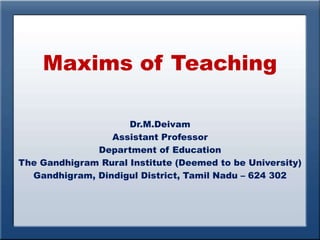
Maxims of Teaching
- 1. Maxims of Teaching Dr.M.Deivam Assistant Professor Department of Education The Gandhigram Rural Institute (Deemed to be University) Gandhigram, Dindigul District, Tamil Nadu – 624 302
- 2. From Known to Unknown • When a child enters into school, he possesses some knowledge and it is the duty of teacher to enlarge his previous knowledge. Whatever he possesses should be linked with the new knowledge. • If we link new knowledge with the old knowledge our teaching becomes clearer and more definite.
- 3. From Simple to Complex • In the process of teaching and learning, simple or easy things should be first presented to the students and gradually he should proceed towards complex or difficult things. • The presentation of simple material makes the learners interested, confident and feels encouraged.
- 4. From Concrete to Abstract • As Froebel said, “Our lessons ought to start in the concrete and end in the abstract”. • Concrete things are solid things and they can be visualized but abstract things are only imaginative things. • The child understands more easily when taught through their senses and never forget that material. On the other hand if abstract things or ideas are presented, they forget it soon.
- 5. From Analysis to Synthesis • When we divide a things into easy parts in order to understand it easily is called analysis. • The process of analysis is easier than synthesis for understanding a thing. • This process develops the analytical power of the students. It is the best method of starting the teaching process.
- 6. From Particular to General • General facts, principles and ideas are difficult to understand and hence the teacher should always first present particular things and then lead to general things. • Suppose the teacher is teaching continuous tense while teaching English, he should first of all give few examples and then on the basis of those make them generalize that this tense is used to denote an action that is going on at the time of speaking.
- 7. From Empirical to Rational • Empirical knowledge is that which is based on observation and experience about which no reasoning is needed at all. It is concrete, particular and simple. We can feel and experience it. On the other hand rational knowledge is based upon arguments and explanations. • For example suppose the students are to be taught that water boils on heating. They should first be made to heat the water and see it boiling. Then the teacher should explain that when water is heated, the molecules gain kinetic energy and there is thermal agitation of the molecules which make the water boil.
- 8. From Induction to Deduction • Inductive reasoning is supplying some evidence or argument to conclude to the truth. Broad generalizations are made from definite observation. • Deductive Reasoning is when every possibilities are examined to reach to a valid conclusion. • Aryan ethnicity were horse riders. Horses were found in Central Asia. Therefore, Aryans came from Central Asia. ( Inductive) • Where did Aryans ethnicity come from? DNA evidence, Archaeological findings, archival texts etc. somewhat indicating a conclusion (Deductive)
- 9. From Psychological to Logical • Psychological approach takes into consideration the pupil his interests, abilities, aptitudes, development level, needs and reactions. • The teacher should keep in mind the psychological selection of the subject matter to be presented before the pupils. • Logical approach considers the arrangement of the chosen content in to logical order and steps.
- 10. From Actual to Representative • A teacher while selecting the content for presentation should make all efforts possible to present it through actual, natural or real objects than from their improvised representative one’s like pictures, models etc. First hand experiences makes learning more vivid and efficient than to give them representative ones. • For example to teach about ‘Golden Temple Amritsar’, a teacher should try his best to visit the actual place and that learning will be more vivid and the pupils will retain it for a long time in spite of teaching through sketches, model or a picture. Representative forms should be used at the higher classes than in lower classes.
- 11. From Whole to Part • The student should be acquainted with complete lesson, chapter, concept, theory or idea first and then breakdown different elements for discussion • Prose (Whole) explanation of every paragraph (Part) • Poetry (Whole) Word Exposition (Part)
- 12. From Definite to indefinite • A teacher should always start from definite because definiteness has its limited boundaries and jurisdiction than indefinite things. Hence a teacher while teaching any content should first present definite things, ideas and then he can learn indefinite things easily. • Indefinite: “I’m going to eat an apple.” This could be any apple, we don’t know which one. • Definite: “I’m going to eat the apple.” We do know which apple I’m going to eat.
